The Cambridge History of China. Vol. 13: Republican China 1912-1949, Part 2
Подождите немного. Документ загружается.

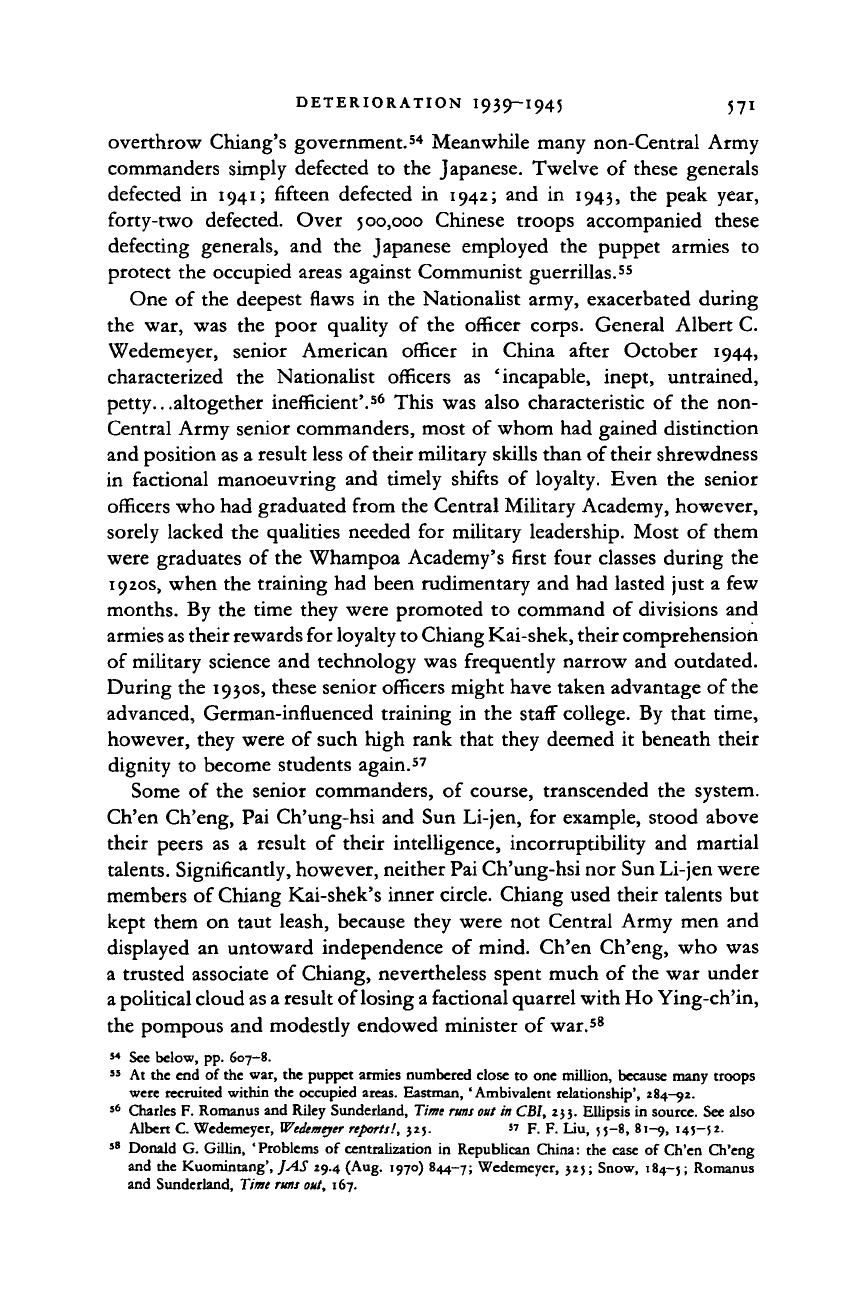
DETERIORATION I939—1945 571
overthrow Chiang's government.
54
Meanwhile many non-Central Army
commanders simply defected to the Japanese. Twelve of these generals
defected in 1941; fifteen defected in 1942; and in 1943, the peak year,
forty-two defected. Over 500,000 Chinese troops accompanied these
defecting generals, and the Japanese employed the puppet armies to
protect the occupied areas against Communist guerrillas.
55
One of the deepest flaws in the Nationalist army, exacerbated during
the war, was the poor quality of the officer corps. General Albert C.
Wedemeyer, senior American officer in China after October 1944,
characterized the Nationalist officers as 'incapable, inept, untrained,
petty.. .altogether inefficient'.
56
This was also characteristic of the non-
Central Army senior commanders, most of whom had gained distinction
and position as a result less of their military skills than of their shrewdness
in factional manoeuvring and timely shifts of loyalty. Even the senior
officers who had graduated from the Central Military Academy, however,
sorely lacked the qualities needed for military leadership. Most of them
were graduates of the Whampoa Academy's first four classes during the
1920s, when the training had been rudimentary and had lasted just a few
months. By the time they were promoted to command of divisions and
armies
as
their rewards for loyalty to Chiang Kai-shek, their comprehension
of military science and technology was frequently narrow and outdated.
During the 1930s, these senior officers might have taken advantage of the
advanced, German-influenced training in the staff college. By that time,
however, they were of such high rank that they deemed it beneath their
dignity to become students again.
57
Some of the senior commanders, of course, transcended the system.
Ch'en Ch'eng, Pai Ch'ung-hsi and Sun Li-jen, for example, stood above
their peers as a result of their intelligence, incorruptibility and martial
talents. Significantly, however, neither Pai Ch'ung-hsi nor Sun Li-jen were
members of Chiang Kai-shek's inner circle. Chiang used their talents but
kept them on taut leash, because they were not Central Army men and
displayed an untoward independence of mind. Ch'en Ch'eng, who was
a trusted associate of Chiang, nevertheless spent much of the war under
a political cloud as a result of losing a factional quarrel with Ho Ying-ch'in,
the pompous and modestly endowed minister of war.
58
54
See
below,
pp.
607-8.
55
At
the end
of
the
war, the
puppet armies numbered close
to
one
million, because many troops
were recruited within
the
occupied areas. Eastman, 'Ambivalent relationship', 284-92.
56
Charles
F.
Romanus
and
Riley Sunderland, Time runs
out in
CBI,
233. Ellipsis
in
source.
See
also
Albert
C.
Wedemeyer, Wedemeyer reports!,
325.
» F. F. Liu, 55-8, 81-9,
145-52.
s8
Donald
G.
Gillin, 'Problems
of
centralization
in
Republican China:
the
case
of
Ch'en Ch'eng
and
the
Kuomintang',
JAS 29.4
(Aug.
1970)
844-7; Wedemeyer, 325; Snow, 184-5; Romanus
and Sunderland, Time
runs
out,
167.
Cambridge Histories Online © Cambridge University Press, 2008
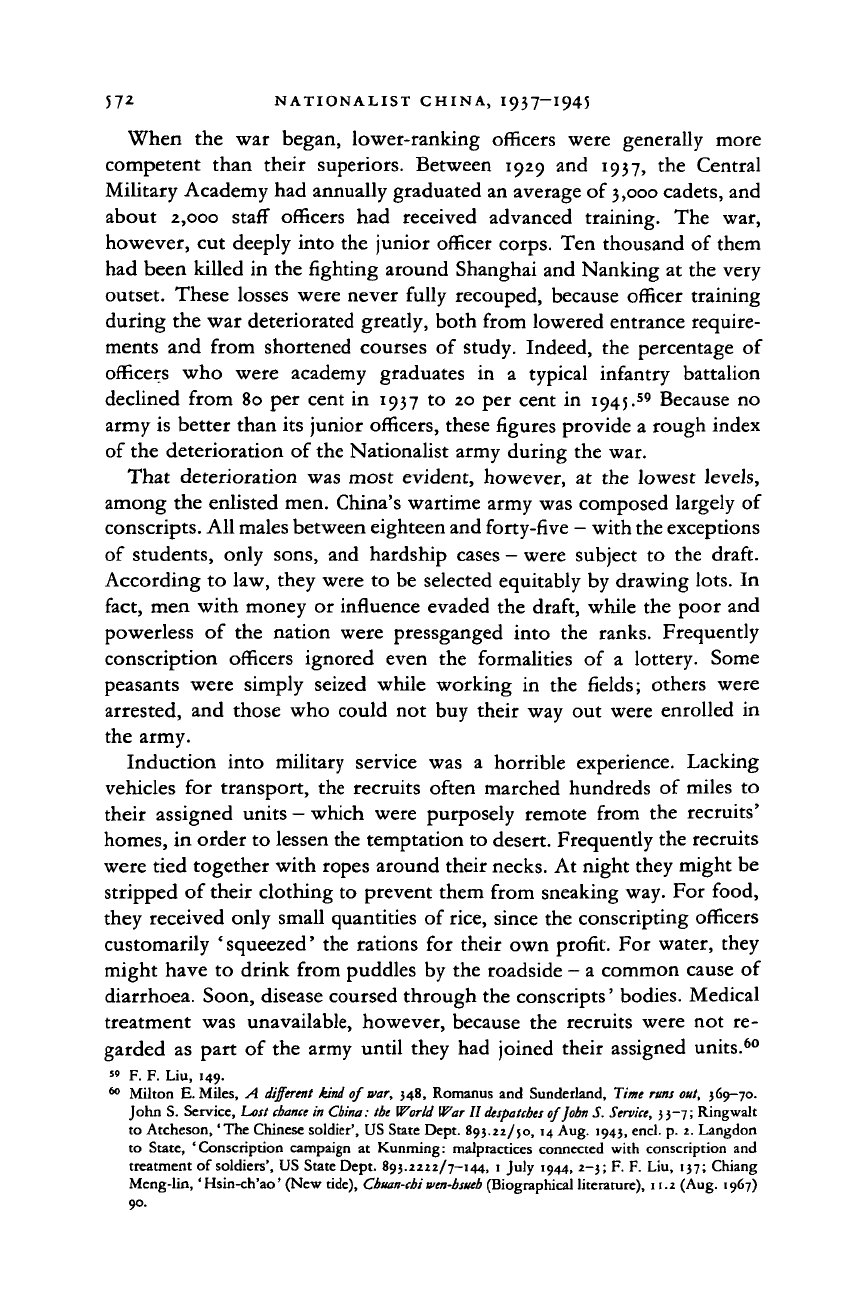
57
2
NATIONALIST CHINA, 1937—1945
When
the war
began, lower-ranking officers were generally more
competent than their superiors. Between 1929
and
1937,
the
Central
Military Academy had annually graduated an average
of
3,000 cadets, and
about 2,000 staff officers
had
received advanced training.
The war,
however, cut deeply into the junior officer corps. Ten thousand
of
them
had been killed in the fighting around Shanghai and Nanking at the very
outset. These losses were never fully recouped, because officer training
during the war deteriorated greatly, both from lowered entrance require-
ments and from shortened courses
of
study. Indeed, the percentage
of
officers
who
were academy graduates
in a
typical infantry battalion
declined from 80 per cent
in
1937
to
20 per cent
in
1945.
59
Because
no
army is better than its junior officers, these figures provide a rough index
of the deterioration
of
the Nationalist army during the war.
That deterioration was most evident, however,
at the
lowest levels,
among the enlisted men. China's wartime army was composed largely of
conscripts. All males between eighteen and forty-five
-
with the exceptions
of students, only sons,
and
hardship cases
-
were subject
to the
draft.
According to law, they were
to
be selected equitably by drawing lots.
In
fact, men with money
or
influence evaded the draft, while the poor and
powerless
of
the nation were pressganged into
the
ranks. Frequently
conscription officers ignored even
the
formalities
of a
lottery. Some
peasants were simply seized while working
in the
fields; others were
arrested, and those who could
not
buy their way out were enrolled
in
the army.
Induction into military service
was a
horrible experience. Lacking
vehicles
for
transport, the recruits often marched hundreds
of
miles
to
their assigned units
-
which were purposely remote from
the
recruits'
homes, in order to lessen the temptation to desert. Frequently the recruits
were tied together with ropes around their necks. At night they might be
stripped of their clothing to prevent them from sneaking way. For food,
they received only small quantities of rice, since the conscripting officers
customarily 'squeezed' the rations
for
their own profit. For water, they
might have
to
drink from puddles by the roadside
-
a common cause of
diarrhoea. Soon, disease coursed through the conscripts' bodies. Medical
treatment was unavailable, however, because
the
recruits were
not re-
garded
as
part
of
the army until they had joined their assigned units.
60
»• F. F. Liu, 149.
60
Milton E. Miles,
A
different
kind
of
mar,
348, Romanus and Sunderland, Time
runs
out,
369-70.
John S. Service, Lost
dance in
China:
the World War II
despatches
of
}obn
S.
Service,
33-7; Ringwalt
to Atcheson, 'The Chinese soldier', US State Dept. 893.22/jo,
14
Aug.
1943,
end. p. 2. Langdon
to State, 'Conscription campaign
at
Kunming: malpractices connected with conscription and
treatment of soldiers', US State Dept. 893.2222/7-144, 1 July 1944, 2-3; F. F. Liu, 137; Chiang
Meng-lin, 'Hsin-ch'ao' (New tide),
Cbuan-cbi wen-bsueb
(Biographical literature), 11.2 (Aug. 1967)
90.
Cambridge Histories Online © Cambridge University Press, 2008
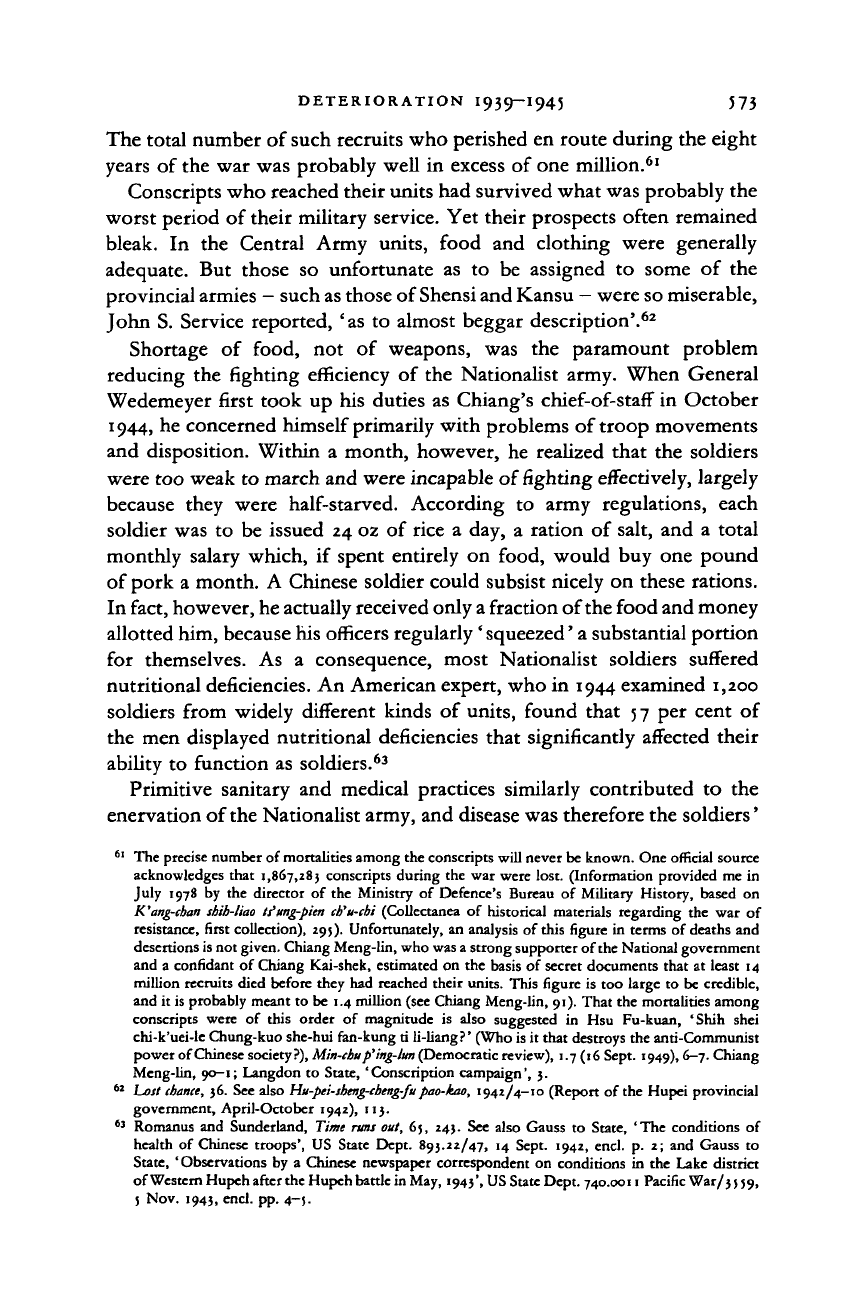
DETERIORATION 1939—1945 573
The total number of such recruits who perished en route during the eight
years of the war was probably well in excess of one million.
61
Conscripts who reached their units had survived what was probably the
worst period of their military service. Yet their prospects often remained
bleak. In the Central Army units, food and clothing were generally
adequate. But those so unfortunate as to be assigned to some of the
provincial armies - such
as
those of Shensi and Kansu - were so miserable,
John S. Service reported, 'as to almost beggar description'.
62
Shortage of food, not of weapons, was the paramount problem
reducing the fighting efficiency of the Nationalist army. When General
Wedemeyer first took up his duties as Chiang's chief-of-staff in October
1944,
he concerned himself primarily with problems of troop movements
and disposition. Within a month, however, he realized that the soldiers
were too weak to march and were incapable of fighting effectively, largely
because they were half-starved. According to army regulations, each
soldier was to be issued 24 oz of rice a day, a ration of salt, and a total
monthly salary which, if spent entirely on food, would buy one pound
of pork a month. A Chinese soldier could subsist nicely on these rations.
In fact, however, he actually received only
a
fraction of the food and money
allotted him, because his officers regularly ' squeezed' a substantial portion
for themselves. As a consequence, most Nationalist soldiers suffered
nutritional deficiencies. An American expert, who in 1944 examined 1,200
soldiers from widely different kinds of units, found that
5 7
per cent of
the men displayed nutritional deficiencies that significantly affected their
ability to function as soldiers.
63
Primitive sanitary and medical practices similarly contributed to the
enervation of
the
Nationalist army, and disease was therefore the soldiers'
61
The
precise number
of
mortalities among
the
conscripts will never
be
known.
One
official source
acknowledges that 1,867,283 conscripts during
the war
were lost. (Information provided
me in
July
1978 by the
director
of the
Ministry
of
Defence's Bureau
of
Military History, based
on
K'ang-cbatt sbih-liao ttung-pitn cb'u-cbi (Collectanea
of
historical materials regarding
the war of
resistance, first collection),
295).
Unfortunately,
an
analysis
of
this figure
in
terms
of
deaths
and
desertions
is not
given. Chiang Meng-lin,
who was a
strong supporter
of
the National government
and
a
confidant
of
Chiang Kai-shek, estimated
on the
basis
of
secret documents that
at
least
14
million recruits died before they
had
reached their units. This figure
is too
large
to be
credible,
and
it is
probably meant
to be 1.4
million
(see
Chiang Meng-lin,
91).
That
the
mortalities among
conscripts were
of
this order
of
magnitude
is
also suggested
in Hsu
Fu-kuan, 'Shih shei
chi-k'uei-le Chung-kuo she-hui fan-kung
ti
li-liang?'
(Who is it
that destroys
the
anti-Communist
power
of
Chinese society?), Min-cbu
p'ing-lun
(Democratic review),
1.7 (16
Sept. 1949), 6—7. Chiang
Meng-lin, 90-1; Langdon
to
State, 'Conscription campaign',
3.
62
Loit chance,
36. See
also Hu-pti-sbeng-cbeng-fupao-kao, 1942/4-10 (Report
of the
Hupei provincial
government, April-October 1942),
113.
63
Romanus
and
Sunderland, Time runs
out, 65, 243. See
also Gauss
to
State,
'The
conditions
of
health
of
Chinese troops',
US
State Dept. 893.22/47,
14
Sept.
1942,
encl.
p. 2; and
Gauss
to
State, 'Observations
by a
Chinese newspaper correspondent
on
conditions
in the
Lake district
of Western Hupeh after the Hupeh battle
in
May, 1943',
US
State Dept. 740.0011 Pacific War/35 59,
; Nov.
1943, encl.
pp. 4—j.
Cambridge Histories Online © Cambridge University Press, 2008
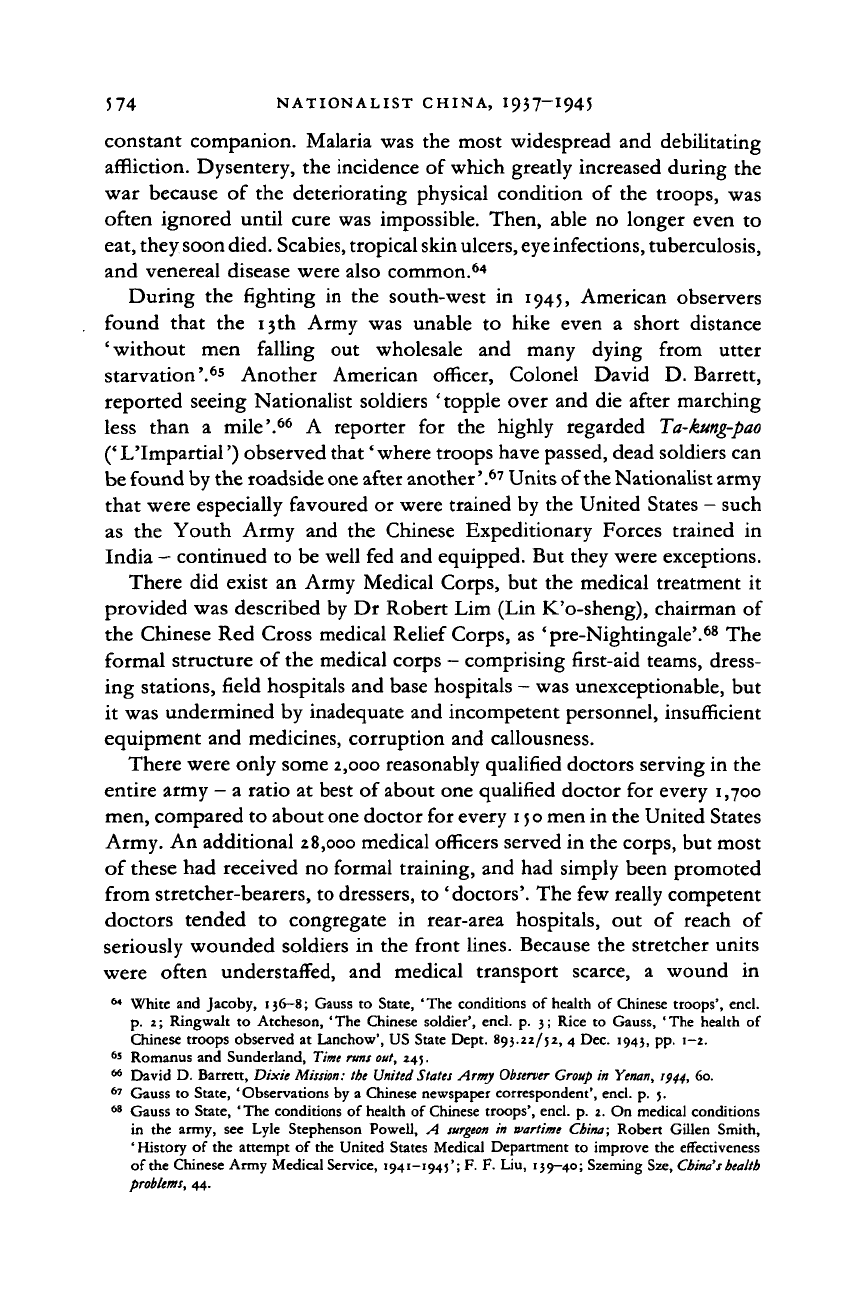
574 NATIONALIST CHINA, I937-I945
constant companion. Malaria was the most widespread and debilitating
affliction. Dysentery, the incidence of which greatly increased during the
war because
of
the deteriorating physical condition
of
the troops, was
often ignored until cure was impossible. Then, able no longer even
to
eat, they soon
died.
Scabies,
tropical skin
ulcers,
eye infections, tuberculosis,
and venereal disease were also common.
64
During the fighting
in
the south-west
in
1945, American observers
found that the ijth Army was unable
to
hike even
a
short distance
'without
men
falling
out
wholesale
and
many dying from utter
starvation'.
65
Another American officer, Colonel David D. Barrett,
reported seeing Nationalist soldiers 'topple over and die after marching
less than
a
mile'.
66
A
reporter
for the
highly regarded Ta-kung-pao
(' L'Impartial') observed that' where troops have passed, dead soldiers can
be found by the roadside one after another'.
67
Units of the Nationalist army
that were especially favoured or were trained by the United States
—
such
as the Youth Army and the Chinese Expeditionary Forces trained
in
India
—
continued to be well fed and equipped. But they were exceptions.
There did exist an Army Medical Corps, but the medical treatment
it
provided was described by Dr Robert Lim (Lin K'o-sheng), chairman of
the Chinese Red Cross medical Relief Corps, as 'pre-Nightingale'.
68
The
formal structure of the medical corps
-
comprising first-aid teams, dress-
ing stations, field hospitals and base hospitals
-
was unexceptionable, but
it was undermined by inadequate and incompetent personnel, insufficient
equipment and medicines, corruption and callousness.
There were only some 2,000 reasonably qualified doctors serving in the
entire army
-
a ratio at best of about one qualified doctor for every 1,700
men, compared to about one doctor for every
150
men in the United States
Army. An additional 28,000 medical officers served in the corps, but most
of these had received no formal training, and had simply been promoted
from stretcher-bearers, to dressers, to 'doctors'. The few really competent
doctors tended
to
congregate
in
rear-area hospitals,
out of
reach
of
seriously wounded soldiers in the front lines. Because the stretcher units
were often understaffed,
and
medical transport scarce,
a
wound
in
64
White
and
Jacoby, 136-8; Gauss
to
State, 'The conditions
of
health
of
Chinese troops', encl.
p.
2;
Ringwalt
to
Atcheson, ' The Chinese soldier', encl.
p. 3;
Rice
to
Gauss,
'
The health
of
Chinese troops observed
at
Lanchow',
US
State Dept. 893.22/52,
4
Dec. 1943, pp.
1-2.
65
Romanus
and
Sunderland, Time runs out, 245.
66
David
D.
Barrett, Dixie Mission:
the
United States Army Observer Group
in
Yenan, 1944,
60.
67
Gauss
to
State,
'
Observations
by a
Chinese newspaper correspondent', encl.
p. 5.
68
Gauss
to
State, 'The conditions
of
health
of
Chinese troops', encl.
p. 2. On
medical conditions
in
the
army,
see
Lyle Stephenson Powell,
A
surgeon
in
wartime China; Robert Gillen Smith,
'
History
of
the attempt
of
the United States Medical Department
to
improve
the
effectiveness
of the Chinese Army Medical Service, 1941-1945';
F. F.
Liu, 139-40; Szeming Sze, China's health
problems, 44.
Cambridge Histories Online © Cambridge University Press, 2008
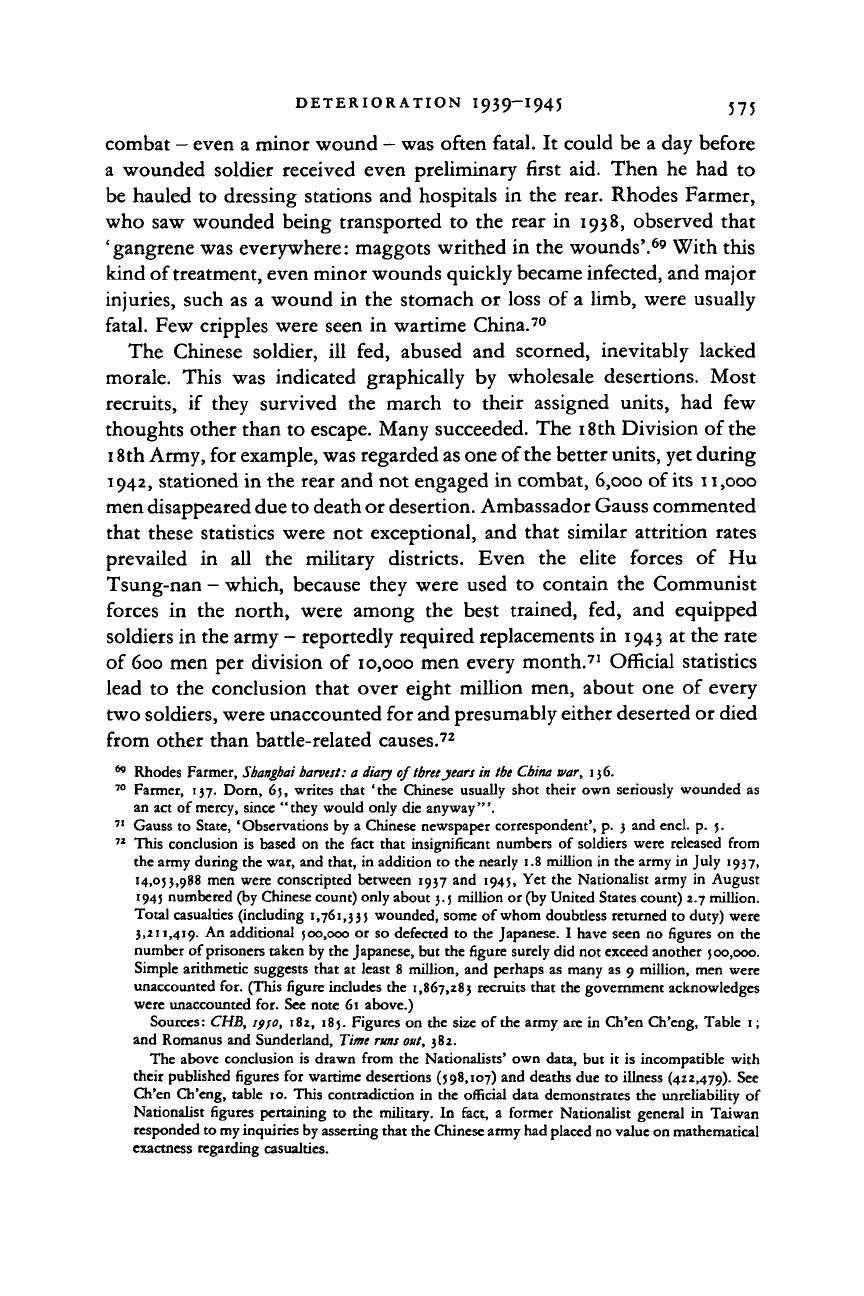
DETERIORATION I939—1945 5-75
combat
—
even a minor wound
—
was often fatal. It could be a day before
a wounded soldier received even preliminary first aid. Then he had to
be hauled to dressing stations and hospitals in the rear. Rhodes Farmer,
who saw wounded being transported to the rear in 1938, observed that
'gangrene was everywhere: maggots writhed in the wounds'.
69
With this
kind of treatment, even minor wounds quickly became infected, and major
injuries, such as a wound in the stomach or loss of a limb, were usually
fatal. Few cripples were seen in wartime China.
70
The Chinese soldier, ill fed, abused and scorned, inevitably lacked
morale. This was indicated graphically by wholesale desertions. Most
recruits, if they survived the march to their assigned units, had few
thoughts other than to escape. Many succeeded. The 18th Division of the
18th Army, for example, was regarded as one of the better units, yet during
1942,
stationed in the rear and not engaged in combat, 6,000 of
its
11,000
men disappeared due to death or desertion. Ambassador Gauss commented
that these statistics were not exceptional, and that similar attrition rates
prevailed in all the military districts. Even the elite forces of Hu
Tsung-nan - which, because they were used to contain the Communist
forces in the north, were among the best trained, fed, and equipped
soldiers in the army - reportedly required replacements in 1943 at the rate
of 600 men per division of 10,000 men every month.
71
Official statistics
lead to the conclusion that over eight million men, about one of every
two soldiers, were unaccounted for and presumably either deserted or died
from other than battle-related causes.
72
65
Rhodes Farmer, Shanghai harvest: a diary of three years in the China war, 136.
70
Farmer, 137. Dorn, 65, writes that 'the Chinese usually shot their own seriously wounded as
an act of mercy, since "they would only die anyway"'.
" Gauss to State, 'Observations by a Chinese newspaper correspondent', p. 3 and end. p. 5.
" This conclusion is based on the fact that insignificant numbers of soldiers were released from
the army during the war, and that, in addition to the nearly 1.8 million in the army in July 1937,
14,053,988 men were conscripted between 1937 and 1945, Yet the Nationalist army in August
194J numbered (by Chinese count) only about 3.5 million or (by United States count) 2.7 million.
Total casualties (including
1,761,335
wounded, some of whom doubtless returned to duty) were
3,211,419. An additional 500,000 or so defected to the Japanese. I have seen no figures on the
number of prisoners taken by the Japanese, but the figure surely did not exceed another 500,000.
Simple arithmetic suggests that at least 8 million, and perhaps as many as 9 million, men were
unaccounted for. (This figure includes the
1,867,283
recruits that the government acknowledges
were unaccounted for. See note 61 above.)
Sources: CHS, ifjo, 182, 185. Figures on the size of the army are in Ch'en Ch'eng, Table 1;
and Romanus and Sunderland, Time
runs
out,
382.
The above conclusion is drawn from the Nationalists' own data, but it is incompatible with
their published figures for wartime desertions (598,107) and deaths due to illness (422,479). See
Ch'en Ch'eng, table 10. This contradiction in the official data demonstrates the unreliability of
Nationalist figures pertaining to the military. In fact, a former Nationalist general in Taiwan
responded to my inquiries by asserting that the Chinese army had placed no value on mathematical
exactness regarding casualties.
Cambridge Histories Online © Cambridge University Press, 2008
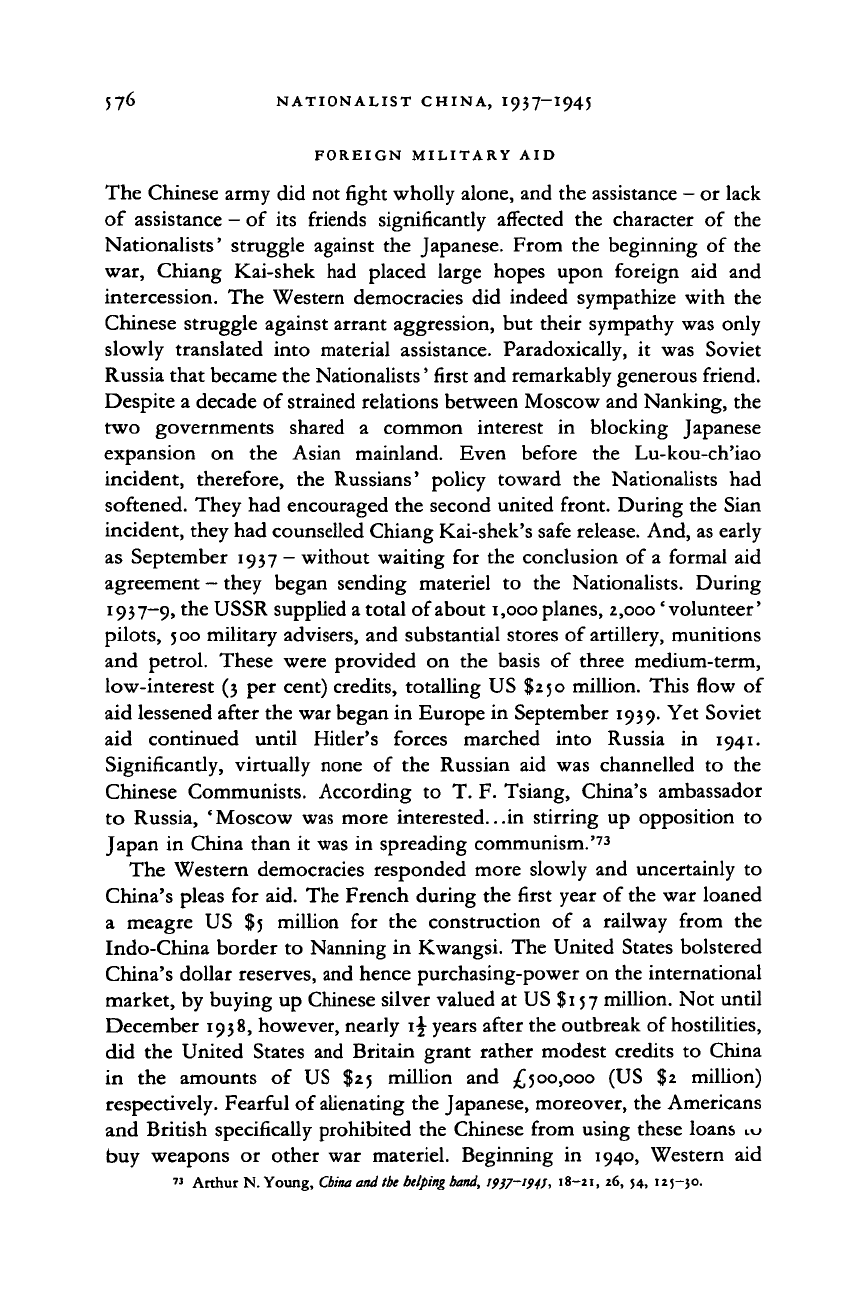
576 NATIONALIST CHINA, I937-I945
FOREIGN MILITARY AID
The Chinese army did not fight wholly alone, and the assistance
—
or lack
of assistance
- of its
friends significantly affected
the
character
of the
Nationalists' struggle against the Japanese. From the beginning
of
the
war, Chiang Kai-shek
had
placed large hopes upon foreign
aid and
intercession. The Western democracies did indeed sympathize with
the
Chinese struggle against arrant aggression, but their sympathy was only
slowly translated into material assistance. Paradoxically,
it
was Soviet
Russia that became the Nationalists' first and remarkably generous friend.
Despite a decade of strained relations between Moscow and Nanking, the
two governments shared
a
common interest
in
blocking Japanese
expansion
on the
Asian mainland. Even before
the
Lu-kou-ch'iao
incident, therefore,
the
Russians' policy toward
the
Nationalists
had
softened. They had encouraged the second united front. During the Sian
incident, they had counselled Chiang Kai-shek's safe release. And, as early
as September 1937
-
without waiting
for
the conclusion
of
a formal aid
agreement
-
they began sending materiel
to the
Nationalists. During
1937—9,
the USSR supplied a total of about 1,000 planes, 2,000 'volunteer'
pilots,
500 military advisers, and substantial stores of artillery, munitions
and petrol. These were provided
on the
basis
of
three medium-term,
low-interest (3 per cent) credits, totalling US $250 million. This flow
of
aid lessened after the war began in Europe in September 1939. Yet Soviet
aid continued until Hitler's forces marched into Russia
in 1941.
Significantly, virtually none
of
the Russian
aid
was channelled
to the
Chinese Communists. According
to
T. F. Tsiang, China's ambassador
to Russia, 'Moscow was more interested...in stirring
up
opposition
to
Japan
in
China than
it
was
in
spreading communism.'
73
The Western democracies responded more slowly and uncertainly
to
China's pleas for aid. The French during the first year of the war loaned
a meagre
US $5
million
for the
construction
of a
railway from
the
Indo-China border to Nanning
in
Kwangsi. The United States bolstered
China's dollar reserves, and hence purchasing-power on the international
market, by buying up Chinese silver valued at US $157 million. Not until
December 1938, however, nearly i£ years after the outbreak of hostilities,
did
the
United States and Britain grant rather modest credits
to
China
in
the
amounts
of US $25
million
and
£500,000
(US $2
million)
respectively. Fearful of alienating the Japanese, moreover, the Americans
and British specifically prohibited the Chinese from using these loans
LO
buy weapons
or
other war materiel. Beginning
in
1940, Western
aid
73
Arthur N. Young,
China
and the helping
band,
19)7-194;,
18-21,
26,
54,
125-30.
Cambridge Histories Online © Cambridge University Press, 2008
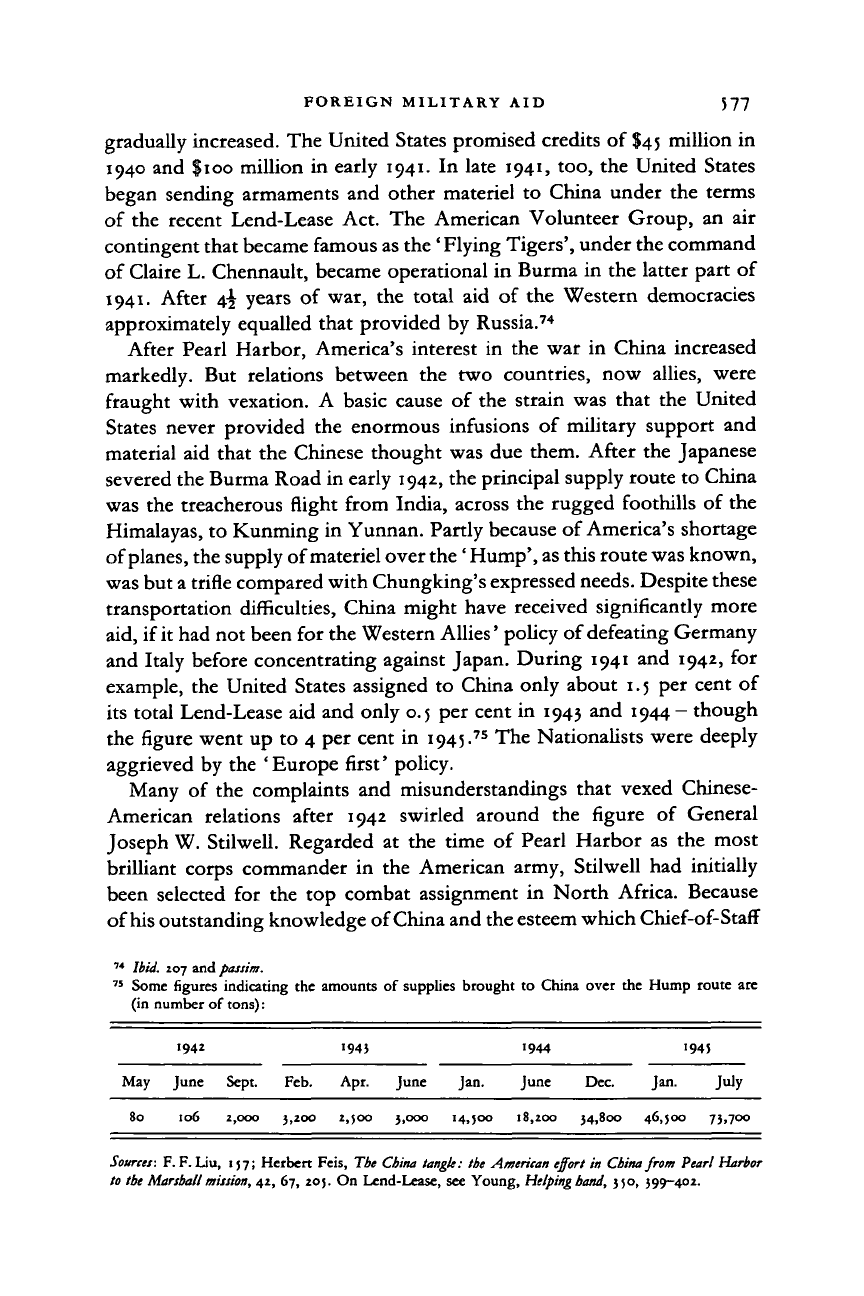
FOREIGN MILITARY AID 577
gradually increased. The United States promised credits of
$45
million in
1940 and $100 million in early 1941. In late 1941, too, the United States
began sending armaments and other materiel to China under the terms
of the recent Lend-Lease Act. The American Volunteer Group, an air
contingent that became famous as the' Flying Tigers', under the command
of Claire L. Chennault, became operational in Burma in the latter part of
1941.
After 4^ years of war, the total aid of the Western democracies
approximately equalled that provided by Russia.
74
After Pearl Harbor, America's interest in the war in China increased
markedly. But relations between the two countries, now allies, were
fraught with vexation. A basic cause of the strain was that the United
States never provided the enormous infusions of military support and
material aid that the Chinese thought was due them. After the Japanese
severed the Burma Road in early 1942, the principal supply route to China
was the treacherous flight from India, across the rugged foothills of the
Himalayas, to Kunming in Yunnan. Partly because of America's shortage
of planes, the supply of materiel over the'
Hump',
as this route was known,
was but a trifle compared with Chungking's expressed needs. Despite these
transportation difficulties, China might have received significantly more
aid, if it had not been for the Western Allies' policy of defeating Germany
and Italy before concentrating against Japan. During 1941 and 1942, for
example, the United States assigned to China only about 1.5 per cent of
its total Lend-Lease aid and only 0.5 per cent in 1943 and 1944 - though
the figure went up to 4 per cent in 1945." The Nationalists were deeply
aggrieved by the 'Europe first' policy.
Many of the complaints and misunderstandings that vexed Chinese-
American relations after 1942 swirled around the figure of General
Joseph W. Stilwell. Regarded at the time of Pearl Harbor as the most
brilliant corps commander in the American army, Stilwell had initially
been selected for the top combat assignment in North Africa. Because
of his outstanding knowledge of China and the esteem which Chief-of-Staff
74
Ibid.
207 and
passim.
75
Some figures indicating
the
amounts
of
supplies brought
to
China over
the
Hump route
are
(in number
of
tons):
May
80
1942
June
106
Sept.
2,000
Feb.
3,200
"945
Apr.
2,500
June
3,000
Jan.
14,500
•944
June
18,200
Dec.
34,800
"945
Jan.
July
46.500 75.7OO
Sources: F. F. Liu, i J7; Herbert Feis, The China tangle: the American effort in
China
from Pearl Harbor
to the Marshall
mission,
42, 67, 20J. On Lend-Lease, see Young, Helping
band,
350, 399-402.
Cambridge Histories Online © Cambridge University Press, 2008
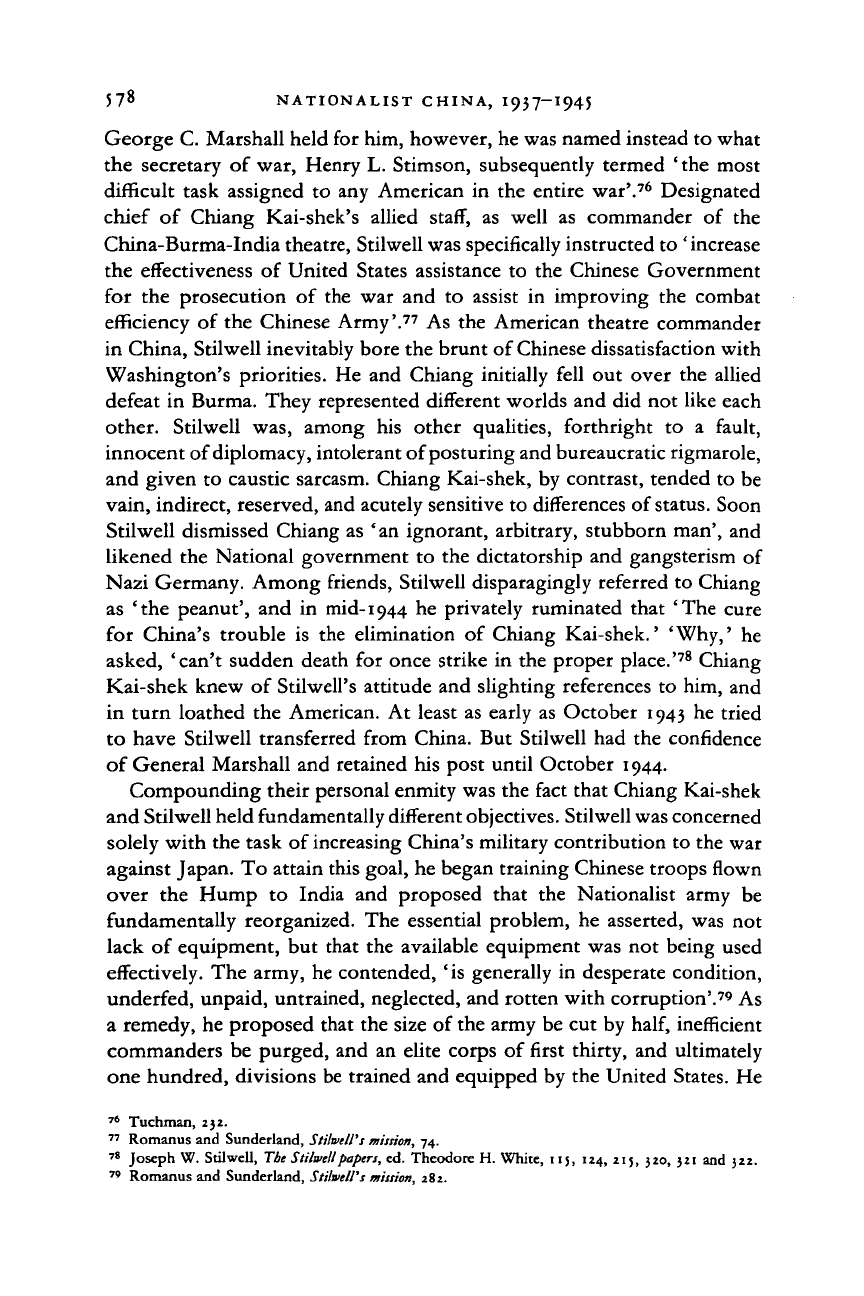
NATIONALIST CHINA, I937-I945
George
C.
Marshall held
for
him, however,
he
was named instead
to
what
the secretary
of war,
Henry
L.
Stimson, subsequently termed ' the most
difficult task assigned
to any
American
in the
entire war'.
76
Designated
chief
of
Chiang Kai-shek's allied
staff, as
well
as
commander
of
the
China-Burma-India theatre, Stilwell was specifically instructed
to
' increase
the effectiveness
of
United States assistance
to the
Chinese Government
for
the
prosecution
of the war and to
assist
in
improving
the
combat
efficiency
of the
Chinese Army'.
77
As the
American theatre commander
in China, Stilwell inevitably bore
the
brunt
of
Chinese dissatisfaction with
Washington's priorities.
He and
Chiang initially fell
out
over
the
allied
defeat
in
Burma. They represented different worlds
and did not
like each
other. Stilwell
was,
among
his
other qualities, forthright
to a
fault,
innocent of diplomacy, intolerant of posturing and bureaucratic rigmarole,
and given
to
caustic sarcasm. Chiang Kai-shek,
by
contrast, tended
to be
vain, indirect, reserved,
and
acutely sensitive
to
differences
of
status.
Soon
Stilwell dismissed Chiang
as 'an
ignorant, arbitrary, stubborn
man', and
likened
the
National government
to the
dictatorship
and
gangsterism
of
Nazi Germany. Among friends, Stilwell disparagingly referred
to
Chiang
as
'the
peanut',
and in
mid-1944
he
privately ruminated that
'The
cure
for China's trouble
is the
elimination
of
Chiang Kai-shek.' ' Why,'
he
asked, 'can't sudden death
for
once strike
in the
proper place.'
78
Chiang
Kai-shek knew
of
StilwelPs attitude
and
slighting references
to him, and
in turn loathed
the
American.
At
least
as
early
as
October
1943 he
tried
to have Stilwell transferred from China.
But
Stilwell
had the
confidence
of General Marshall
and
retained
his
post until October
1944.
Compounding their personal enmity
was the
fact that Chiang Kai-shek
and Stilwell held fundamentally different objectives. Stilwell was concerned
solely with
the
task
of
increasing China's military contribution
to the war
against Japan.
To
attain this goal,
he
began training Chinese troops flown
over
the
Hump
to
India
and
proposed that
the
Nationalist army
be
fundamentally reorganized.
The
essential problem,
he
asserted,
was not
lack
of
equipment,
but
that
the
available equipment
was not
being used
effectively.
The
army,
he
contended,
'
is
generally
in
desperate condition,
underfed, unpaid, untrained, neglected,
and
rotten with corruption'.
79
As
a remedy,
he
proposed that
the
size
of
the army
be cut by half,
inefficient
commanders
be
purged,
and an
elite corps
of
first thirty,
and
ultimately
one hundred, divisions
be
trained
and
equipped
by the
United States.
He
76
Tuchman,
232.
77
Romanus
and
Sunderland, Stilwell's mission,
74.
78
Joseph
W.
Stilwell,
Tie
Stilwell papers,
ed.
Theodore
H.
White,
iij,
124, 215,
320, 321 and 322.
n
Romanus
and
Sunderland, Stilwell's mission,
282.
Cambridge Histories Online © Cambridge University Press, 2008
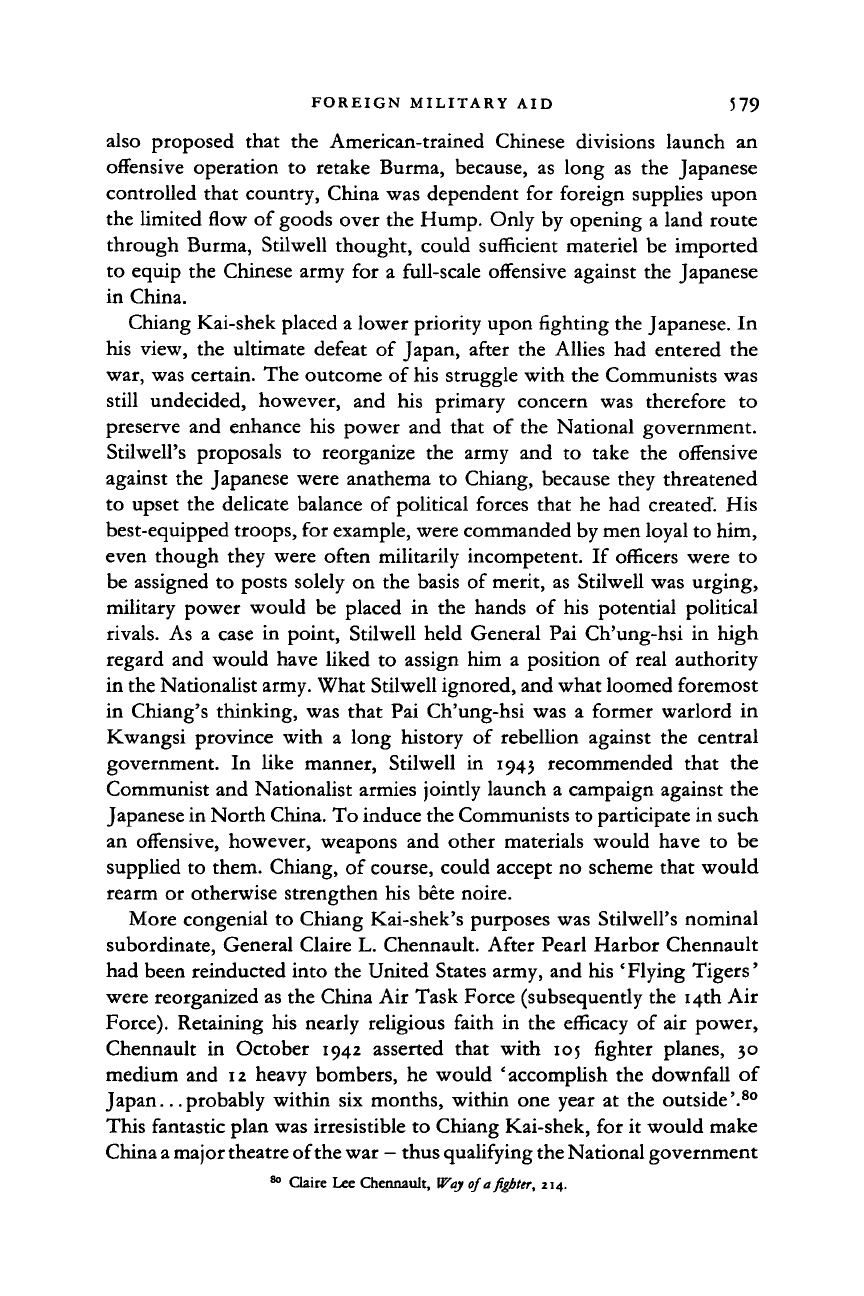
FOREIGN MILITARY AID 579
also proposed that the American-trained Chinese divisions launch an
offensive operation to retake Burma, because, as long as the Japanese
controlled that country, China was dependent for foreign supplies upon
the limited flow of goods over the Hump. Only by opening a land route
through Burma, Stilwell thought, could sufficient materiel be imported
to equip the Chinese army for a full-scale offensive against the Japanese
in China.
Chiang Kai-shek placed a lower priority upon fighting the Japanese. In
his view, the ultimate defeat of Japan, after the Allies had entered the
war, was certain. The outcome of his struggle with the Communists was
still undecided, however, and his primary concern was therefore to
preserve and enhance his power and that of the National government.
Stilwell's proposals to reorganize the army and to take the offensive
against the Japanese were anathema to Chiang, because they threatened
to upset the delicate balance of political forces that he had created'. His
best-equipped troops, for example, were commanded by men loyal to him,
even though they were often militarily incompetent. If officers were to
be assigned to posts solely on the basis of merit, as Stilwell was urging,
military power would be placed in the hands of his potential political
rivals.
As a case in point, Stilwell held General Pai Ch'ung-hsi in high
regard and would have liked to assign him a position of real authority
in the Nationalist army. What Stilwell ignored, and what loomed foremost
in Chiang's thinking, was that Pai Ch'ung-hsi was a former warlord in
Kwangsi province with a long history of rebellion against the central
government. In like manner, Stilwell in 1943 recommended that the
Communist and Nationalist armies jointly launch a campaign against the
Japanese in North China. To induce the Communists to participate in such
an offensive, however, weapons and other materials would have to be
supplied to them. Chiang, of course, could accept no scheme that would
rearm or otherwise strengthen his bete noire.
More congenial to Chiang Kai-shek's purposes was Stilwell's nominal
subordinate, General Claire L. Chennault. After Pearl Harbor Chennault
had been reinducted into the United States army, and his ' Flying Tigers'
were reorganized as the China Air Task Force (subsequently the 14th Air
Force).
Retaining his nearly religious faith in the efficacy of air power,
Chennault in October 1942 asserted that with 105 fighter planes, 30
medium and 12 heavy bombers, he would 'accomplish the downfall of
Japan.. .probably within six months, within one year at the outside'.
80
This fantastic plan was irresistible to Chiang Kai-shek, for it would make
China
a
major theatre of the war - thus qualifying the National government
80
Claire Lee Chennault, Way of
a
fighter, 214.
Cambridge Histories Online © Cambridge University Press, 2008

580 NATIONALIST CHINA, I937-I945
for larger quotas
of
material
aid
—
without requiring large expenditures
of
her own
resources.
And the
army reforms
and
active participation
in
the ground
war,
which Stilwell
was
demanding, would
be
unnecessary.
Stilwell, backed
by
General Marshall
and
secretary
of
War
Henry
L.
Stimson
in
Washington, vehemently opposed
the
Chennault plan.
Its
crucial flaw,
he
argued,
was
that
the
Japanese would attack
and
destroy
the American
air
bases
as
soon
as the air
strikes became effective. With
the Chinese army
in its
current ineffectual condition, those
air
bases would
be completely vulnerable.
But
Roosevelt sided with Chennault
and
Chiang
Kai-shek,
and
Chennault's
air
offensive began.
By
November
1943,
Japanese bases within China
and
their shipping along
the
China coast were
sustaining significant losses. Japanese authorities, moreover, feared
the
Americans would
use the air
bases
at
Kweilin
and
Liu-chou
to
launch
raids
on the
home islands, damaging their
war
industries. Stilwell's worst
fears were then soon realized.
For in
April
1944, the
Japanese launched
the Ichigo (Operation Number
One)
offensive, their largest
and
most
destructive campaign in China
since
19
3
8.
It
sliced through
the
Nationalists'
defensive lines, posing
a
threat even
to
Kunming,
a
strategic
key to all
unoccupied China. This military threat coincided with
an
economic slump
and mounting political discontent.
The success
of
the
Ichigo campaign made China's military situation
desperate. Seeking a solution
to
the crisis, Roosevelt
on
19 September
1944
demanded that Chiang Kai-shek place Stilwell
'in
unrestricted command
of
all
your forces'.
81
Stilwell, after personally delivering
the
message,
recorded
in his
diary: '
I
handed this bundle
of
paprika
to the
Peanut
and
then
sat
back with
a
sigh.
The
harpoon
hit the
little bugger right
in the
solar plexus,
and
went right through
him. It was a
clean
hit, but
beyond
turning green
and
losing
the
power
of
speech,
he did not bat an
eye.
'*
2
But Stilwell's exultation
was brief.
Chiang knew that, with Stilwell
in
command
of
the war
effort, political power
in
China would slowly
perhaps,
but
surely, slip from
his
grasp. This
he
could
not
accept
and
with
indomitable insistence
he
persuaded Roosevelt
to
recall Stilwell.
On
19
October
1944,
General Albert C. Wedemeyer
was
named Chiang's
chief-
of-staff
and
commander
of
United States forces
in
China.
JAPAN S ICHIGO OFFENSIVE I 944
Japan's Ichigo offensive inflicted
a
devastating defeat upon the Nationalists.
It revealed
to all
Chinese
and to the
world
how
terribly
the
Nationalist
81
Romanus
and
Sunderland, Stilwell's command problems, 443-6; Tuchman, 492-5.
82
Stilwell
papers,
355.
Cambridge Histories Online © Cambridge University Press, 2008
